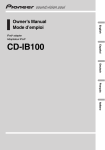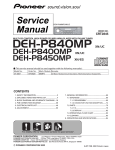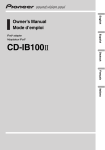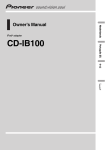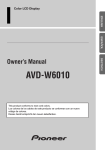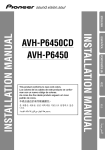Download Pioneer GEX-P6400TV TV Receiver User Manual
Transcript
ENGLISH Hide-away TV tuner FRANÇAIS Syntoniseur de télévision déporté DEUTSCH FRANÇAIS Operation Manual Mode d’emploi ITALIANO GEX-P6400TV NEDERLANDS Contents Dear Customer ............................................ 2 Before Using This Product ...................... 3 About This Product .......................................... 3 - Video system of a connected component - This product’s power source Important .......................................................... 3 About This Manual ............................................ 4 Precaution .......................................................... 4 - After-sales Service for Pioneer Products Resetting the Microprocessor ............................ 5 OSD Switch Setting .......................................... 5 Key Finder .................................................... 6 Optional Remote Control CD-R99 (sold separately) - The Head Unit (e.g. DEH-P8400MP) - Operating with Head Unit ........................ 8 Head Unit Group 1 Head Unit Group 2 - Head Unit Group 3 - Head Unit Group 4 Function Compatibility Charts .......................... 9 - Preset Memory - Direct Recall - Entering the Function Menu - Preset Scan - Switching the Tuning Mode - Using the PGM Button - Preset ch. List - 1 Basic Operation ...................................... 12 Switching the Source ...................................... 12 Basic Operation of TV Tuner .......................... 13 - Manual and Seek Tuning - BAND - Preset Tuning BSSM (Best Station Sequential Memory) ...... 14 Confirming Current Channel and Other Settings .......................................... 15 Specifications .......................................... 16 ENGLISH ESPAÑOL Selecting fine audio equipment such as the unit you’ve just purchased is only the start of your musical enjoyment. Now it’s time to consider how you can maximize the fun and excitement your equipment offers. This manufacturer and the Electronic Industries Association’s Consumer Electronics Group want you to get the most out of your equipment by playing it at a safe level. One that lets the sound come through loud and clear without annoying blaring or distortion—and, most importantly, without affecting your sensitive hearing. Sound can be deceiving. Over time your hearing “comfort level” adapts to higher volumes of sound. So what sounds “normal” can actually be loud and harmful to your hearing. Guard against this by setting your equipment at a safe level BEFORE your hearing adapts. To establish a safe level: • Start your volume control at a low setting. • Slowly increase the sound until you can hear it comfortably and clearly, and without distortion. DEUTSCH Once you have established a comfortable sound level: • Set the dial and leave it there. Taking a minute to do this now will help to prevent hearing damage or loss in the future. After all, we want you listening for a lifetime. We Want You Listening For A Lifetime FRANÇAIS Used wisely, your new sound equipment will provide a lifetime of fun and enjoyment. Since hearing damage from loud noise is often undetectable until it is too late, this manufacturer and the Electronic Industries Association’s Consumer Electronics Group recommend you avoid prolonged exposure to excessive noise. This list of sound levels is included for your protection. Decibel Level Example 30 Quiet library, soft whispers 40 Living room, refrigerator, bedroom away from traffic 50 Light traffic, normal conversation, quiet office 60 Air conditioner at 20 feet, sewing machine 70 Vacuum cleaner, hair dryer, noisy restaurant 80 Average city traffic, garbage disposals, alarm clock at two feet. ITALIANO NEDERLANDS THE FOLLOWING NOISES CAN BE DANGEROUS UNDER CONSTANT EXPOSURE 90 Subway, motorcycle, truck traffic, lawn mower 100 Garbage truck, chain saw, pneumatic drill 120 Rock band concert in front of speakers, thunderclap 140 Gunshot blast, jet plane 180 Rocket launching pad Information courtesy of the Deafness Research Foundation. 2 Before Using This Product Information to User Alternation or modifications carried out without appropriate authorization may invalidate the user’s right to operate the equipment. [For Canadian model] This Class B digital apparatus complies with Canadian ICES-003. About This Product This product is a TV tuner for reception of TV broadcasts. Combining it with a separately sold display with AV-BUS lets you enjoy TV entertainment (refer to this product’s Installation Manual for details concerning the AV-BUS). The tuner frequencies on this product are allocated for use in North America. Use in other areas may result in improper reception. This product features a Rear Display output (REAR OUT), letting you watch TV on a Rear Display (sold separately). Video system of a connected component This product is NTSC system compatible. When connecting an external component to this product’s Rear Display output (REAR OUT), be sure the component is compatible with the same video systems. If it is not, images will not be correctly reproduced. WARNING • Be sure to stop driving and park your car in a safe place before watching the TV. • Watching the TV while driving is dangerous and could result in an accident. • This product’s Rear Display output is for connection of a display to enable passengers in the rear seats to watch the TV. Do not install the rear display in a location that enables the driver to watch the TV while driving. This product’s power source Switching power to the unit controlling this product OFF, or selecting a source other than TV does not switch power to this product OFF. Although this product is designed to assure no problems occur during use, if for some reason you want to switch power OFF, switch ACC OFF on the car side. Important The serial number of this device is located on the bottom of this product. For your own security and convenience, be sure to record this number on the enclosed warranty card. 3 About This Manual ENGLISH This product features a number of sophisticated functions ensuring superior reception and operation. All are designed for the easiest possible use, but many are not self-explanatory. This operation manual is intended to help you benefit fully from their potential and to maximize your listening enjoyment. We recommend that you familiarize yourself with the functions and their operation by reading through the manual before you begin using this product. It is especially important that you read and observe the “Precaution” on this page and in other sections. ESPAÑOL When using with a Pioneer AV Receiver (e.g. AVH-P6400CD, AVH-P6400), please read the AV Receiver’s Operation Manual. Precaution Keep this manual handy as a reference for operating procedures and precautions. Always keep the volume low enough for outside sounds to be audible. Protect this product from moisture. If the battery is disconnected, the preset memory will be erased and must be reprogrammed. DEUTSCH • • • • After-sales Service for Pioneer Products 7 U.S.A. 7 CANADA Pioneer Electronics of Canada, Inc. CUSTOMER SATISFACTION DEPARTMENT 300 Allstate Parkway, Markham, Ontario L3R OP2 (905) 479-4411 1-877-283-5901 ITALIANO Pioneer Electronics (U.S.A.), Inc. CUSTOMER SUPPORT DIVISION P.O. Box 1760 Long Beach, CA 90801-1760 800-421-1404 FRANÇAIS Please contact the dealer or distributor from where you purchased the product for its aftersales service (including warranty conditions) or any other information. In case the necessary information is not available, please contact the companies listed below: Please do not ship your product to the companies at the addresses listed below for repair without advance contact. For warranty information please see the Limited Warranty sheet included with your product. NEDERLANDS 4 Before Using This Product Resetting the Microprocessor The microprocessor must be reset under the following conditions: When using this product for the first time after installation. When the machine fails to operate properly. When strange (incorrect) messages appear on the display. When setting the position of the OSD switch on the right side of this product. If you reset the microprocessor, memorized broadcast stations and other information is erased, and this product returns to its initial settings. • To reset the microprocessor, press the RESET button on the unit with a pen tip or other pointed instrument. OSD Switch Setting 2 OSD TV 1 Set the OSD (On Screen Display) switch on the right side of this product to the appropriate position with a pen tip or other pointed instrument, for the component you are combining it with. (1) OSD OFF When combining with a PIONEER AV Receiver (e.g. AVH-P6400CD, AVH-P6400). • Select this setting when not using this product’s OSD indications in the display. (2) OSD ON When combining with a PIONEER Display featuring an AV-BUS input (e.g. AVXP7300DVD, AVX-7300). • Select this setting when using this product’s OSD indications in the display. Note: 5 • As output from the Rear Display output has no relation to the OSD switch’s ON/OFF setting, OSD indications are always displayed. Key Finder Optional Remote Control CD-R99 (sold separately) ENGLISH The optional remote control CD-R99 is mainly for use by rear seat passengers. When using, point at the front seat display remote control sensor. POWER MENU TOP RTN S.TITLE DISP 1 CH CALL button DVD TV BAND BSSM/ ch call ANGLE ESPAÑOL MENU AUDIO 2 Joystick/ 5/∞/2/3 buttons Mode switch RGB MENU V.SEL REAR WIDE ANGLE 1 2 3 4 5 6 10 7 8 9 0 DEUTSCH OPEN/CLOSE OPEN/CLOSE C CLEAR FRANÇAIS 7 Other remote controls The optional remote control CD-R99 ITALIANO You can also perform operations with the remote controls shown below. Operate using the buttons that correspond to those on the optional remote control CD-R99, as shown in the chart. A Pioneer car DVD player’s remote control* 1 CH CALL button STEP (E) button 2 5/∞/2/3 buttons Joystick NEDERLANDS Mode switch: When operating a TV, be sure to set the “Remote control operation mode switch” to the “TV” position. *…SDV-P7, AVX-P7300DVD, XDV-P9II 6 Key Finder The Head Unit (e.g. DEH-P8400MP) You can control this unit with a Head Unit (sold separately). SOURCE button VOLUME 1–6 (PRESET TUNING) buttons 5/∞/2/3 buttons BAND button Front panel (open) FUNCTION button Note: • Button layout differs depending on the model, so please read the Operation Manual of the Head Unit you are using. 7 Operating with Head Unit ENGLISH These instructions explain how to operate this product with a connected Head Unit (sold separately). Some Head Units control this product as a TV source, while others control it as an External Unit. Among Head Units that control this product as an External Unit, some do it using a FUNCTION button and some do not. Note: ESPAÑOL • External Unit refers to a component that cannot be fully controlled by a Head Unit as a source. • When connected to a Head Unit that cannot control a TV as a source, this product (TV) is controlled as an External Unit. • Two types of Pioneer Head Unit are available: one type to which only one external unit can be connected and another type to which two external units can be connected. 7 Head Unit Group 1 Head Units that control this product as a TV source. 7 Head Unit Group 2 DEUTSCH Head Units that control this product as an External Unit using a FUNCTION button to operate functions. 7 Head Unit Group 3 Head Units that control this product as an External Unit, not using a FUNCTION button to operate functions. 7 Head Unit Group 4 FRANÇAIS Head Units that control this product as a TV source, not using a FUNCTION button to operate functions. Head Unit Group 1 ITALIANO NEDERLANDS When using the unit with one of these Head Units, operate while referring to Head Unit Group 1 in the Function Compatibility Charts. DEX-P9 DEH-P90HDD DEH-P940MP DEH-P9400MP DEH-P9300 DEH-P930 DEH-P8400MP DEH-P840MP DEH-P8200R DEH-P7400MP DEH-P740MP DEH-P7300 DEH-P730 DEH-P7200 DEH-P720 DEH-P6400 DEH-P640 DEH-P6300 DEH-P630 DEH-P6200 DEH-P5200 DEH-P520 DEH-P4400 DEH-P440 DEH-P44 DEH-P4300 DEH-P430 DEH-P43 DEH-P3300 DEH-P330 DEH-P33 DEH-P3370XM DEH-P77DH KEH-P6010 KEH-P601 KEH-P690 FH-P4100 FH-P4000 AVM-P9000R AVM-P8000R AVH-P6400CD AVH-P6400 DVH-P7000 8 Operating with Head Unit Head Unit Group 2 When using the unit with one of these Head Units, operate while referring to Head Unit Group 2 in the Function Compatibility Charts. DEH-P4100 DEH-P410 DEH-P41 FH-P8800 Head Unit Group 3 When using the unit with one of these Head Units, operate while referring to Head Unit Group 3 in the Function Compatibility Charts. KEH-P4900 KEH-P490 KEH-P4010 KEH-P1010 Head Unit Group 4 When using the unit with one of these Head Units, operate while referring to Head Unit Group 4 in the Function Compatibility Charts. KEH-P4020 Function Compatibility Charts Operate using buttons with the same function on the Head Unit itself or the remote control. Note: • You may not be able to use functions* with some Head Units. Head Unit Group 1 Function Button Operation Page Switching the Source SOURCE, SOURCE/OFF :Select 12 Manual Tuning (Step by Step) 2/3 (0.5 seconds or less) :Select 13 Seek Tuning 2/3 (0.5 seconds or more) :Select 13 Preset Tuning 5/∞ :Select 13 Changing the Band BAND, 23 :Select 13 Preset Memory 1–6 (Hold for 2 seconds) :Memory 10 Direct Recall 1–6 :Select 11 BSSM FUNCTION (A.MENU) 5/∞ :ON/OFF 14 Preset ch. List* FUNCTION (A.MENU) 5/∞/2/3 Setting the PGM Button* FUNCTION (Hold for 2 seconds) 5/∞/2/3 :Select — Using the PGM Button* PGM (Hold for 2 seconds) :BSSM ON/OFF 11 11 Note: • For TV, you cannot memorize functions other than BSSM in the PGM button. (You may not be able to use this function with some Head Units.) • When using with an AV Receiver (e.g. AVH-P6400CD, AVH-P6400), please read the AV Receiver’s Operation Manual. 9 Head Unit Group 2 Page :Select 12 Manual or Seek Tuning 2/3 :Select 13 Preset Tuning 5/∞ :Select 13 Changing the Band BAND, 23 :Select 13 Preset Memory 1–6 (Hold for 2 seconds) :Memory 10 Direct Recall 1–6 :Select 11 Entering the Function Menu FUNCTION :Select 11 Preset Scan* (FUNC 1) 5/∞ :ON/OFF 11 BSSM (FUNC 1) 5/∞ (Hold for 2 seconds) :ON/OFF 14 Switching the Tuning Mode* (AUTO/MANUAL) 5/∞ :Select 11 Setting the PGM Button* FUNCTION (Hold for 2 seconds) 5/∞/2/3 :Select — Using the PGM Button* PGM/DSP, PGM :BSSM ON/OFF 11 DEUTSCH Operation SOURCE, SOURCE/OFF ESPAÑOL Button Switching the Source ENGLISH Function Head Unit Group 3 and 4 Function Button Operation Page Switching the Source SOURCE, SOURCE/OFF :Select 12 :Select 11 2/3 :Select 13 Preset Tuning 5/∞ :Select 13 Changing the Band BAND, 23 :Select 13 Preset Memory 1–6 (Hold for 2 seconds) :Memory 10 Direct Recall 1–6 :Select 11 BSSM DISPLAY button (Hold for 2 seconds) :ON/OFF 14 Preset Scan DISPLAY button :Select 11 ITALIANO RPT button Manual or Seek Tuning FRANÇAIS Switching the Tuning Mode Note: NEDERLANDS • The button for Preset Scan differs depending on the model. * KEH-P4020: BSM button * KEH-P4010: PAUSE/SCAN button • The button for Switching the Tuning Mode differs depending on the model. * KEH-P4020: LOCAL button * KEH-P4010, KEH-P4900, KEH-P490: LOCAL/BSM button Preset Memory The Preset Memory function stores stations in memory manually. 1. Select the station whose channel you want to store in memory. 2. Press one of buttons 1–6 for 2 seconds or longer to store the desired stations. Note: • The station is stored in memory under the selected button. • You cannot memorize in Preset channels 7–12 with this function. 10 Operating with Head Unit Direct Recall • Press one of buttons 1–6 to recall a station preset under that button. Note: • To recall Preset channels 7–12, perform Preset Tuning with 5/∞ buttons. Entering the Function Menu • Press the FUNCTION button to select the desired mode in the Function Menu. Each press of the FUNCTION button selects the mode in the following order: FUNC 1 (Preset Scan/BSSM) = FUNC 2 = FUNC 3 = FUNC 4 = AUTO/MANUAL (Switching the Tuning Mode) Note: • In FUNC 1, Preset Scan or BSSM is selected by changing the length of time you press the 5/∞ button. • There are no functions in FUNC 2, FUNC 3 or FUNC 4. Preset Scan This lets you view up to 12 stations stored in the Preset Channels one after the other. Switching the Tuning Mode You can select between Manual Tuning (MANUAL) and Seek Tuning (AUTO). Press the 5/∞ button, or other button as appropriate, and tuning is performed in the selected tuning mode. Using the PGM Button The PGM (PGM/DSP) button operates in a different way depending on the function programmed (memorized). (For details concerning programming the PGM (PGM/DSP) button, refer to the Head Unit’s operation manual.) • Press the PGM (PGM/DSP) button. Function Press Hold for 2 seconds Preset Scan/BSSM (FUNC1) Preset Scan ON/OFF BSSM ON/OFF Switching the Tuning Mode (AUTO/MANUAL) Select _____ Preset ch. List Read the Operation Manual of a Head Unit that can use this function. 11 Basic Operation ENGLISH When using with a Pioneer AV Receiver (e.g. AVH-P6400CD, AVH-P6400), please read the AV Receiver’s Operation Manual. Switching the Source 7 Head Unit Group 1 and 4 ESPAÑOL 1. Switch the display image source to this product. For details, refer to the connected unit’s manual. 2. Select the TV source on the Head Unit. 2 Channel P1 Preset Number DEUTSCH Each press changes the Source ... 7 Head Unit Group 2 and 3 FRANÇAIS 1. Switch the display image source to this product. For details, refer to the connected unit’s manual. 2. Set the source to “External” (or “TV”, “Television”). Note: ITALIANO • Switching power to the Head Unit (the unit controlling this product) OFF, or selecting a source other than TV does not switch power to this product OFF. Although this product is designed to assure no problems occur during use, if for some reason you want to switch power OFF, switch ACC OFF on the car side. • With Head Unit Group 2 or 3 models, “TV” or “Television” may not be indicated in the display. NEDERLANDS 12 Basic Operation Basic Operation of TV Tuner Manual and Seek Tuning • You can select the tuning method by changing the length of time you press the 2/3 button. Manual Tuning (step by step) 0.5 seconds or less Seek Tuning 0.5 seconds or more Note: • If you continue pressing the button for longer than 0.5 seconds, you can skip broadcasting stations. Seek Tuning starts as soon as you stop pressing the button. BAND TV1 = TV2 Operation is possible only with the Head Unit’s BAND (23) button. 2 Audio source Channel P1 Audio Number Preset source Preset Tuning • You can recall memorized stations. You can memorize and recall stations using buttons 1–6 in the same way as with Head Unit tuner Preset Tuning. (Refer to page 11.) 13 BSSM (Best Station Sequential Memory) ENGLISH The BSSM function automatically memorizes strongly transmitted broadcast stations in order from the lowest channel up. Note: • Up to 12 stations can be memorized in 1 Band. • In regions where reception of no more than 12 station is possible, previously memorized stations may remain in memory. ESPAÑOL 7 Head Unit Group 1 1. Press the FUNCTION (A.MENU) button and select the BSSM mode (BSSM) in the FUNCTION (AUDIO) Menu. 2. To switch the BSSM ON, press the 5 button. DEUTSCH FRANÇAIS • To cancel the process, press the ∞ button in the FUNCTION (AUDIO) Menu before memorization is complete. 7 Head Unit Group 2 1. Press the FUNCTION button and select the Preset Scan/BSSM mode (FUNC 1) in the Function Menu. 2. To switch the BSSM ON, press the 5 button for 2 seconds. ITALIANO • To cancel the process, press the ∞ button in the Function Menu before memorization is complete. 7 Head Unit Group 3 and 4 • To switch the BSSM ON, press the DISPLAY button for 2 seconds. NEDERLANDS • To cancel the process, press the DISPLAY button again before memorization is complete. Note: • The button for BSSM differs depending on the model. * KEH-P4020: BSM button * KEH-P4010: PAUSE/SCAN button 14 Basic Operation 7 The optional remote control CD-R99 You can also perform BSSM with the optional remote control CD-R99. • To switch the BSSM ON, press the CH CALL button for 2 seconds. • To cancel the process, press the CH CALL button for 2 seconds again before memorization is complete. Confirming Current Channel and Other Settings If the current audio source is TV, reception information such as the channel and band is displayed. You can also display to the preset channel list. • Select the desired mode in the following order: (Channel Recall) AUDIO RTN S.TITLE DISP BSSM/ ch call ANGLE BAND DVD TV 2 Channel TV 1 Band RGB MENU V.SEL Each Press changes the Mode ... Channel Recall = Preset channel list = Indication OFF (Preset channel list) 2 TV 1 2 4 6 7 10 13 14 25 36 46 57 69 Channels memorized (preset) in that Band Note: • Recalled indications are displayed for 8 seconds. 15 Specifications General ENGLISH Power source .............................................................................................. 14.4 V DC (10.8 — 15.1 V allowable) Grounding system .............................................................................................................................. Negative type Max. current consumption .............................................................................................................................. 0.5 A Dimensions .......................................................................................................... 172 (W) × 30 (H) × 148 (D) mm [6-3/4 (W) × 1-1/8(H) × 5-7/8 (D) in.] Weight .............................................................................................................................................. 0.7 kg (1.5 lbs) TV tuner ESPAÑOL Reception channel/TV system ............................................................ US/M : VHF 2 — 13 ch, UHF 14 — 69 ch Color system .................................................................................................................................. NTSC compatible Usable sensitivity ............................................................................................................................................ 12 dBµ Video S/N ................................................................................ Over 37 dB (59 dBµ RF input, White Peak 100%) Video S/N 30 dB usable sensitivity ............................................................................................................ 44 dBµ Antenna input ........................................................................................ 4 ch Diversity (φ 3.5 mm Mini plug type) Antenna cable .................................................................................................................................. 6 m (19 ft 8 in) Rear display output DEUTSCH Video .................................................................................................... 1 Vp-p/75 Ω (TV: White 100% Modulated) Sound ...................................................................................... 500 mVrms/Less than 1 kΩ (TV: 100% Modulated) FRANÇAIS ITALIANO NEDERLANDS Note: • Specifications and the design are subject to possible modification without notice due to improvements. 16 Table des matières Cher Client .................................................. 2 Avant d’utiliser cet appareil .................... 3 Quelques mots concernant cet appareil ............ 3 - Système vidéo de l’appareil relié - Alimentation de cet appareil Quelques mots concernant ce mode d’emploi .................................................... 4 Précaution .......................................................... 4 - Service après-vente des produits PIONEER Réinitialisation du microprocesseur .................. 5 Réglage du commutateur OSD .......................... 5 Tableau des commandes .......................... 6 Boîtier de télécommande en option CD-R99 (vendu séparément) - Appareil central (par exemple DEH-P8400MP) - Fonctionnement avec l’élément central ................................ 8 Groupe 1 d’éléments centraux Groupe 2 d’éléments centraux - Groupe 3 d’éléments centraux - Groupe 4 d’éléments centraux Tableaux des compatibilité des fonctions ........ 9 - Mémoire des présélections - Rappel direct - Affichage du menu des fonctions - Examen des présélections - Sélection du mode d’accord - Utilisation de la touche PGM - Liste des canaux préréglés - 1 Opérations de base .................................. 12 Sélection de la source ...................................... 12 Opérations de base sur le syntoniseur de télévision ............................................ 13 - Accord manuel et accord automatique - Gamme - Mise en mémoire des fréquences BSSM (Mémoire séquentiel des meilleures stations) .................................................... 14 Confirmation du canal et des autres réglages .................................................... 15 Caractéristiques techniques ................ 16 ENGLISH Cher Client: FRANÇAIS La sélection d’un équipement audio de qualité comme l’unité que vous venez d’acheter n’est que le début de votre plaisir musical. Maintenant, il est temps de penser à la manière de profiter au maximum des plaisirs que vous offre votre équipement. Ce fabricant et le Groupe “Consumer Electronics Group” de l’Association des Industries Electroniques veut que vous profitiez au maximum de votre équipement en l’utilisation à un niveau sûr. Un niveau qui permet au son d’être fort et clair, sans beuglement ennuyant ou distorsion — et, ce qui est plus important, sans affecter votre ouïe sensible. Le son peut être décevant. Avec le temps, le “niveau de confort” de votre ouïe s’adapte aux volumes sonores plus élevés. Ainsi, les sons “normaux” peuvent en fait être forts et affecter votre ouïe. Protégezvous contre cela en réglant votre équipement à un niveau sûr AVANT l’adaptation de votre ouïe. DEUTSCH Pour établir un niveau sûr: • Démarrer votre commande de volume à un réglage bas. • Augmentez lentement le son jusqu’à ce que vous l’entendiez confortablement et clairement, sans distorsion. Lorsque vous avez établi un niveau sonore confortable: • Réglez le cadran et laissez-le tel quel. En prenant une minute pour faire cela, vous pourrez éviter des dommages ou des pertes de sensibilités d’écoute dans le futur. Après tout, nous voulons que vous écoutiez pendant toute votre vie. Nous voulons que vous écoutiez pendant toute votre vie Niveau de Décibels Exemple Bibliothèque tranquille, chuchotement Salon, réfrigérateur, chambre à distance de la circulation Circulation légère, conversation normale, bureau tranquille Climatiseur à 20 pieds, machine à coudre Aspirateur, sèche-cheveux, restaurant bruyant Circulation moyenne en ville, évacuateurs de déchets, réveils à deux pieds. ITALIANO 30 40 50 60 70 80 FRANÇAIS Utilisé avec sagesse, votre nouvel équipement sonore sera une source de plaisir pendant toute votre vie. Comme les dommages de l’ouïe provenant d’un bruit fort ne sont souvent détectables que lorsqu’il est trop tard, ce fabricant et le Groupe “Consumer Electronics Group” de l’Association des Industries Electroniques vous recommandent d’éviter toute exposition prolongée à un bruit excessif. Cette liste de niveaux sonores est incluse pour votre protection. LES BRUITS SUIVANTS PEUVENT ETRE DANGEREUX DANS LE CAS D’UNE EXPOSITION CONSTANTE NEDERLANDS 90 Métro, motocyclette, circulation de camion, tondeuse à gazon 100 Collecteurs de poubelle, scie à chaîne, perceuse pneumatique 120 Concert de groupe rock devant les haut-parleurs, coup de tonnerre 140 Coup de pistolet, avion à réaction 180 Aire de lancement d’une fusée Ces informations ont été gracieusement fournies par la Fondation de la Recherche pour les Sourds. 2 Avant d’utiliser cet appareil [Pour le modèle Canadien] Cet appareil numérique de la Classe B est conforme à la norme NMB-003 du Canada. Quelques mots concernant cet appareil Cet appareil est un syntoniseur de télévision destiné à la réception des émissions de télévision. Associé à un écran avec AV-BUS vendu séparément, il vous donne la possibilité de regarder des programmes de télévision (pour de plus amples détails concernant l’AV-BUS, reportez-vous au manuel d’installation de cet appareil). Les fréquences sur lesquelles ce syntoniseur peut s’accorder sont dans les gammes employées en Amérique du Nord. L’utilisation de cet appareil dans d’autres régions n’est pas possible. Cet appareil, possède une sortie pour un écran arrière (REAR OUT), ce qui permet de regarder la télévision sur un écran arrière (vendu séparément). Système vidéo de l’appareil relié Cet appareil est compatible NTSC. Avant de relier un appareil extérieur à sa sortie pour écran arrière (REAR OUT), assurez-vous que cet appareil extérieur est bien compatible avec ces systèmes vidéo. Dans le cas contraire, les images ne seront pas convenablement reproduites. ATTENTION • Avant de regarder la télévision, garez le véhicule sur une aire de stationnement sûre. • Regarder la télévision tout en conduisant est dangereux et peut entraîner un accident. • Cet appareil possède une sortie vers écran arrière qui est destiné à permettre aux passagers assis à l’arrière de regarder la télévision. N’installez pas cet écran arrière dans un endroit tel que le conducteur puisse, lui aussi, regarder la télévision tout en conduisant. Alimentation de cet appareil La mise hors tension de l’unité qui commande cet appareil, ou encore le choix d’une source autre que la télévision, ne mettent pas cet appareil hors tension. Bien que cet appareil soit conçu pour être à l’abri des anomalies pendant son fonctionnement, si vous désirez, pour une raison quelconque, le mettre hors tension, placez le contacteur de démarrage du véhicule sur la position ACC OFF. 3 Quelques mots concernant ce mode d’emploi ENGLISH FRANÇAIS Cet appareil est doté de nombreuses fonctions qui permettent la réception dans les meilleures conditions. Ces fonctions sont conçues pour que leur emploi soit aussi aisé que possible mais certaines exigent certaines quelques explications. Ce mode d’emploi a pour objet de vous aider à tirer le meilleur parti des possibilités de l’appareil de façon que votre plaisir d’écouter de la musique soit aussi grand que possible. Nous vous conseillons de lire attentivement ce mode d’emploi afin de vous familiariser avec les fonctions et les modes opératoires. Il est particulièrement important que vous lisiez et respectiez les consignes du paragraphe “Précaution” de cette page et d’autres pages. Si vous utilisez un récepteur audiovisuel Pioneer (par exemple, AVH-P6400CD, AVH-P6400), lisez tout d’abord le mode d’emploi du récepteur audiovisuel. Précaution DEUTSCH • Conservez ce mode d’emploi à portée de main de façon à pouvoir vous y reporter en cas de besoin. • Maintenez le niveau d’écoute à une valeur telle que les bruits extérieurs ne soient pas masqués. • Veillez à ce que l’appareil soit à l’abri de l’humidité. • Si la batterie est débranchée, le contenu de la mémoire des fréquences d’accord est effacé et la remise en mémoire des fréquences est nécessaire. FRANÇAIS Service après-vente des produits PIONEER Veuillez contacter votre revendeur ou distributeur en ce qui concerne le service après-vente (et les conditions de garantie) ou tout autre information. En cas de nécessité ou lorsque l’information recherchée n’est pas disponible, veuillez contacter Pioneer aux adresses suivantes; N’envoyez pas le produit à réparer sans avoir, au préalable, contacté nos bureaux. 7 CANADA Pioneer électroniques du Canada, Inc. Département de service aux consommateurs 300 Allstate Parkway, Markham, Ontario L3R OP2 (905) 479-4411 1-877-283-5901 NEDERLANDS Pioneer Electronics (U.S.A.), Inc. CUSTOMER SUPPORT DIVISION P.O. Box 1760 Long Beach, CA 90801-1760 800-421-1404 ITALIANO 7 U.S.A. Pour de plus amples informations relatives à la garantie, référez-vous au feuillet Garantie Limitée livrée avec l’appareil. 4 Avant d’utiliser cet appareil Réinitialisation du microprocesseur Le microprocesseur doit être réinitialisé dans les conditions suivantes: Lors de l’utilisation de cet appareil pour la première fois après son installation. Lorsque l’appareil ne fonctionne pas correctement. Lorsque des messages étranges (incorrects) apparaissent sur l’affichage. Lorsque vous modifiez la position du commutateur OSD qui se trouve sur le panneau latéral droit de l’appareil. Lors de la réinitialisation du microprocesseur les fréquences des stations mises en mémoire et certaines autres informations sont effacées, tandis que les réglages initiaux sont rétablis. • Pour réinitialiser le microprocesseur, appuyez sur le bouton RESET de l’appareil avec la pointe d’un stylo ou un autre instrument pointu. Réglage du commutateur OSD 2 OSD TV 1 Réglez le commutateur OSD (Affichage sur l’écran), placé sur le côté droit de cet appareil, sur la position convenable compte tenu de l’appareil auquel il est associé; utilisez pour cela la pointe d’un stylo à bille ou un instrument similaire. (1) OSD OFF En association avec un récepteur audiovisuel PIONEER (par exemple, AVH-P6400CD, AVH-P6400). • Sélectionnez ce réglage si vous ne désirez pas faire figurer sur l’écran les indications d’affichage sur l’écran de cet appareil. (2) OSD ON En association avec un écran PIONEER possédant une entrée AV-BUS (par exemple, AVX-P7300DVD, AVX-7300). • Sélectionnez ce réglage si vous désirez faire figurer sur l’écran les indications d’affichage sur l’écran de cet appareil. Remarque: 5 • Comme la sortie de la prise d’affichage arrière n’a aucune relation avec le réglage ON/OFF du commutateur OSD, les indications sur l’écran sont toujours affichées. Tableau des commandes Boîtier de télécommande en option CD-R99 (vendu séparément) ENGLISH Le boîtier de télécommande en option CD-R99 est essentiellement destiné aux passagers des sièges arrière. Dirigez ce boîtier vers le capteur de télécommande de l’afficheur des sièges avant. POWER FRANÇAIS MENU TOP MENU AUDIO RTN S.TITLE DISP 1 Touche CH CALL BSSM/ ch call ANGLE DVD TV BAND 2 Bouton polyvalent/ Touches 5/∞/2/3 Commutateur de mode RGB MENU V.SEL REAR DEUTSCH WIDE OPEN/CLOSE OPEN/CLOSE 1 ANGLE 2 3 C CLEAR 4 5 6 10 7 8 9 0 FRANÇAIS 7 Autres commandes à distance Le boîtier de télécommande en option CD-R99 ITALIANO Vous pouvez également effectuer des opérations à l’aide des commandes à distance cidessous. Agissez sur les touches qui correspondent à celles du boîtier de télécommande en option CD-R99, comme le montre le tableau ci-dessous. Boîtier de télécommande de lecteur de DVD Pioneer* Touche STEP (E) 2 Touches 5/∞/2/3 Bouton polyvalent NEDERLANDS 1 Touche CH CALL Commutateur de mode: Pour la commande d’un téléviseur, n’oubliez pas de placer le “Commutateur de mode de fonctionnement du boîtier de télécommande” sur la position “TV”. *…SDV-P7, AVX-P7300DVD, XDV-P9II 6 Tableau des commandes Appareil central (par exemple DEH-P8400MP) Vous pouvez régler cet appareil grâce à un appareil central (vendu séparément). Touche SOURCE VOLUME Touche 1–6 (PRESET TUNING) Touches 5/∞/2/3 Touche BAND Face avant (ouverte) Touche FUNCTION Remarque: • La disposition des touches dépend du modèle; veuillez donc consulter le mode d’emploi de l’appareil central que vous utilisez. 7 Fonctionnement avec l’élément central ENGLISH Les explications qui suivent vous permettront d’utiliser l’appareil conjointement à l’élément central (vendu séparément) auquel il est relié. Certains éléments centraux considèrent que cet appareil est une source de signaux de télévision, d’autres qu’il s’agit d’un appareil extérieur. Parmi les éléments centraux qui considèrent que cet appareil est un appareil extérieur, certains supposent l’utilisation de la touche FUNCTION, d’autres non. Remarque: FRANÇAIS • Un appareil extérieur est un appareil qui ne peut pas être commandé complètement par l’élément central comme une source. • Si cet appareil est relié à un élément central qui ne peut pas considérer qu’un téléviseur est une source, cet appareil (téléviseur) est traité comme un appareil extérieur. • Deux types d’appareil central Pioneer sont disponibles: un type auquel un seul appareil extérieur peut être raccordé, et un autre type auquel deux appareils extérieurs peuvent être raccordés. 7 Groupe 1 d’éléments centraux Eléments centraux qui considèrent que cet appareil est une source de télévision. 7 Groupe 2 d’éléments centraux DEUTSCH Eléments centraux qui considèrent que cet appareil est un appareil extérieur dont la commande s’effectue au moyen de la touche FUNCTION. 7 Groupe 3 d’éléments centraux Eléments centraux qui considèrent que cet appareil est un appareil extérieur dont la commande ne s’effectue pas au moyen de la touche FUNCTION. 7 Groupe 4 d’éléments centraux FRANÇAIS Eléments centraux qui considèrent que cet appareil est une source de télévision dont la commande ne s’effectue pas au moyen de la touche FUNCTION. Groupe 1 d’éléments centraux ITALIANO NEDERLANDS Si l’appareil est associé à un des éléments centraux suivants, tenez compte de la rubrique Groupe 1 d’éléments centraux du tableau de compatibilité des fonctions. DEX-P9 DEH-P90HDD DEH-P940MP DEH-P9400MP DEH-P9300 DEH-P930 DEH-P8400MP DEH-P840MP DEH-P8200R DEH-P7400MP DEH-P740MP DEH-P7300 DEH-P730 DEH-P7200 DEH-P720 DEH-P6400 DEH-P640 DEH-P6300 DEH-P630 DEH-P6200 DEH-P5200 DEH-P520 DEH-P4400 DEH-P440 DEH-P44 DEH-P4300 DEH-P430 DEH-P43 DEH-P3300 DEH-P330 DEH-P33 DEH-P3370XM DEH-P77DH KEH-P6010 KEH-P601 KEH-P690 FH-P4100 FH-P4000 AVM-P9000R AVM-P8000R AVH-P6400CD AVH-P6400 DVH-P7000 8 Fonctionnement avec l’élément central Groupe 2 d’éléments centraux Si l’appareil est associé à un des éléments centraux suivants, tenez compte de la rubrique Groupe 2 d’éléments centraux du tableau de compatibilité des fonctions. DEH-P4100 DEH-P410 DEH-P41 FH-P8800 Groupe 3 d’éléments centraux Si l’appareil est associé à l’un des éléments centraux suivants, tenez compte de la rubrique Groupe 3 d’éléments centraux du tableau de compatibilité des fonctions. KEH-P4900 KEH-P490 KEH-P4010 KEH-P1010 Groupe 4 d’éléments centraux Si l’appareil est associé à l’un des éléments centraux suivants, tenez compte de la rubrique Groupe 4 d’éléments centraux du tableau de compatibilité des fonctions. KEH-P4020 Tableaux des compatibilité des fonctions Commandez les fonctions au moyen des touches de l’élément central ou du boîtier de télécommande qui portent le même nom. Remarque: • Il se peut que vous ne puissiez pas utiliser les fonctions* avec certains appareils centraux. Groupe 1 d’éléments centraux Fonction Touche Opération Page Sélection de la source SOURCE, SOURCE/OFF :Choisissez 12 Accord manuel (pas à pas) 2/3 (0,5 seconde ou moins) :Choisissez 13 Accord automatique 2/3 (0,5 seconde ou moins) :Choisissez 13 Mise en mémoire des fréquences 5/∞ :Choisissez 13 Sélection de la gamme BAND, 23 :Choisissez 13 Mémoire des présélections 1–6 (Appuyez pendant 2 secondes) :Mémoire 10 Rappel direct 1–6 :Choisissez 11 BSSM FUNCTION (A.MENU) 5/∞ :EN/HORS 14 Liste des canaux préréglés* FUNCTION (A.MENU) 5/∞/2/3 Rôle de la touche PGM* FUNCTION (Appuyez pendant 2 secondes) 5/∞/2/3 :Choisissez — Utilisation de la touche PGM* PGM (Appuyez pendant 2 secondes) :BSSM EN/HORS 11 11 Remarque: 9 • Dans le cas de la télévision, seule la fonction BSSM peut être attribuée à la touche PGM. (Il se peut que vous ne puissiez pas utiliser cette fonction avec certains appareils centraux.) • Si vous utilisez un récepteur audiovisuel (par exemple, AVH-P6400CD, AVH-P6400), lisez tout d’abord le mode d’emploi du récepteur audiovisuel. Groupe 2 d’éléments centraux Opération Page SOURCE, SOURCE/OFF :Choisissez 12 Accord manuel ou automatique 2/3 :Choisissez 13 Mise en mémoire des fréquences 5/∞ :Choisissez 13 Sélection de la gamme BAND, 23 :Choisissez 13 Mémoire des présélections 1–6 (Appuyez pendant 2 secondes) :Mémoire 10 Rappel direct 1–6 :Choisissez 11 Affichage du menu des fonctions FUNCTION :Choisissez 11 Examen des présélections* (FUNC1) 5/∞ :EN/HORS 11 5/∞ (Appuyez pendant 2 secondes) :EN/HORS 14 Sélection du mode d’accord* (AUTO/MANUAL) 5/∞ :Choisissez 11 Rôle de la touche PGM* FUNCTION (Appuyez pendant 2 secondes) 5/∞/2/3 :Choisissez — Utilisation de la touche PGM* PGM/DSP, PGM :BSSM EN/HORS 11 DEUTSCH BSSM (FUNC1) FRANÇAIS Touche Sélection de la source ENGLISH Fonction Groupes 3 et 4 d’éléments centraux Opération Page Sélection de la source SOURCE, SOURCE/OFF :Choisissez 12 Sélection du mode d’accord Touche RPT :Choisissez 11 Accord manuel ou automatique 2/3 :Choisissez 13 Mise en mémoire des fréquences 5/∞ :Choisissez 13 Sélection de la gamme BAND, 23 :Choisissez 13 Mémoire des présélections 1–6 (Appuyez pendant 2 seconds) :Mémoire 10 Rappel direct 1–6 :Choisissez 11 BSSM Touche DISPLAY (Appuyez pendant 2 seconds) :EN/HORS 14 Examen des présélections Touche DISPLAY 11 :Choisissez ITALIANO Touche FRANÇAIS Fonction Remarque: NEDERLANDS • La touche d’examen des présélections diffère selon le modèle. * KEH-P4020: Touche BSM * KEH-P4010: Touche PAUSE/SCAN • La touche de sélection du mode d’accord diffère selon le modèle. * KEH-P4020: Touche LOCAL * KEH-P4010, KEH-P4900, KEH-P490: Touche LOCAL/BSM Mémoire des présélections La mémoire des présélections permet de conserver les fréquences introduites manuellement. 1. Choisissez la station dont la fréquence doit être mise en mémoire. 2. Appuyez, pendant au moins 2 secondes, sur une des touches 1–6 pour mettre en mémoire la fréquence de la station. Remarque: • De la station est conservée par la mémoire correspondante à la touche utilisée. • Cette fonction ne permet pas d’utiliser les mémoires 7–12. 10 Fonctionnement avec l’élément central Rappel direct • Appuyez sur la touche 1–6 ayant servi à la mise en mémoire de la station. Remarque: • Pour les présélections 7–12, effectuez un accord sur présélection à l’aide des touches 5/∞. Affichage du menu des fonctions • Appuyez sur la touche FUNCTION pour sélectionner le mode convenable sur le menu des fonctions. Chaque pression sur la touche FUNCTION, provoque le choix d’un autre mode, dans l’ordre qui suit: FUNC 1 (Examen des présélections/BSSM) = FUNC 2 = FUNC 3 = FUNC 4 = AUTO MANUAL (Sélection du mode d’accord) Remarque: • Avec FUNC1, le choix entre l’examen des présélections ou BSSM s’obtient par la durée de la pression exercée sur la touche 5/∞. • FUNC 2, FUNC 3 et FUNC 4 n’ont aucune fonction. Examen des présélections Vous pouvez, grâce à cette fonction, regarder l’une après l’autre les 12 stations dont les fréquences sont en mémoire. Sélection du mode d’accord Vous avez le choix entre l’accord manuel (MANUAL) et l’accord automatique (AUTO). Appuyez sur la touche 5/∞ ou sur une autre touche appropriée pour effectuer l’accord selon le mode choisi. Utilisation de la touche PGM La touche PGM (PGM/DSP) joue un rôle différent selon la fonction qui lui a été attribuée (mise en mémoire). (Pour de plus amples détails concernant l’attribution d’une fonction à la touche PGM (PGM/DSP), reportez-vous au mode d’emploi de l’élément central.) • Appuyez sur la touche PGM (PGM/DSP). Fonction Action Appuyez pendant 2 secondes Examen des présélections/BSSM (FUNC1) Examen des présélections EN/HORS BSSM EN/HORS Sélection du mode d’accord (AUTO/MANUAL) Choisissez _____ Liste des canaux préréglés Lisez le mode d’emploi d’un appareil central qui peut utiliser cette fonction. 11 Opérations de base ENGLISH Si vous utilisez un récepteur audiovisuel Pioneer (par exemple, AVH-P6400CD, AVH-P6400), lisez tout d’abord le mode d’emploi du récepteur audiovisuel. Sélection de la source 7 Groupes 1 et 4 d’éléments centraux FRANÇAIS 1. Choisissez la source d’image affichée de cet appareil. Pour de plus amples détails, reportez-vous au mode d’emploi de l’appareil relié. 2. Sur l’élément central, choisissez la source de télévision. 2 Canal P1 Numéro de présélection DEUTSCH Chaque pression change la source... 7 Groupes 2 et 3 d’éléments centraux FRANÇAIS 1. Choisissez la source d’image affichée de cet appareil. Pour de plus amples détails, reportez-vous au mode d’emploi de l’appareil relié. 2. Réglez la source sur “External” (ou “TV”, “Television”). Remarque: ITALIANO • La mise hors tension de l’appareil central (l’appareil qui commande cet appareil-ci), ou la sélection d’une source autre que le téléviseur, ne provoquent pas la mise hors tension de cet appareil. Bien que cet appareil soit conçu pour être à l’abri des anomalies pendant son fonctionnement, si vous désirez, pour une raison quelconque, le mettre hors tension, placez le contacteur de démarrage du véhicule sur la position ACC OFF. • Avec les appareils centraux des groupes 2 et 3, les mentions “TV” ou “Television” ne sont pas toujours indiquées sur l’écran. NEDERLANDS 12 Opérations de base Opérations de base sur le syntoniseur de télévision Accord manuel et accord automatique • Vous pouvez choisir la méthode de syntonisation en appuyant plus ou moins longuement sur les touches 2/3. Accord manuel (pas à pas) Pression égale ou inférieure à 0,5 seconde Accord automatique (automatiquement) Pression égale ou supérieure à 0,5 secondes Remarque: • Si vous continuez à appuyer sur la touche pendant plus de 0,5 seconde, les stations sont sautées. L’accord automatique commence dès que vous cessez d’appuyer sur la touche. Gamme TV1 = TV2 Le fonctionnement n’est possible qu’à l’aide de la touche BAND (23) de l’élément central. 2 Canal P1 Numéro de présélection Mise en mémoire des fréquences • Les mémoires associées. Vous pouvez mettre en mémoire des fréquences grâce aux touches 1 à 6 et les rappeler, comme dans le cas du syntoniseur de l’élément central. (Reportez-vous à la page 11.) 13 BSSM (Mémoire séquentiel des meilleures stations) ENGLISH La fonction BSSM permet de mettre en mémoire, automatiquement et dans l’ordre croissant, les fréquences des meilleures stations. Remarque: • Une bande permet la mise en mémoire de 12 stations. • Si moins de 12 stations émettent dans la région, une ou plusieurs fréquences précédemment mises en mémoire peuvent y demeurer. FRANÇAIS 7 Groupe 1 d’éléments centraux 1. Appuyez sur la touche FUNCTION (A.MENU) puis, grâce au menu FUNCTION (AUDIO), choisissez le mode permettant d’utiliser la fonction de mise en mémoire des meilleures stations (BSSM). 2. Pour mettre en service la fonction BSSM, appuyez sur la touche 5. DEUTSCH FRANÇAIS • Pour abandonner la mise en mémoire alors qu’elle est en cours, appuyez sur la touche ∞, le menu FUNCTION (AUDIO) étant affiché. 7 Groupe 2 d’éléments centraux 1. Appuyez sur la touche FUNCTION puis, grâce au menu des fonctions, choisissez le mode permettant d’utiliser l’examen des présélections ou la fonction de mise en mémoire des meilleures stations (FUNC 1). ITALIANO 2. Pour mettre en service la fonction BSSM, appuyez, pendant au moins 2 secondes, sur la touche 5. • Pour abandonner la mise en mémoire alors qu’elle est en cours, appuyez sur la touche ∞, le menu des fonctions étant affiché. 7 Groupe 3 et 4 d’éléments centraux NEDERLANDS • Pour mettre en service la fonction BSSM, appuyez, pendant au moins 2 secondes, sur la touche DISPLAY. • Pour abandonner la mise en mémoire alors qu’elle est en cours, appuyez une nouvelle fois sur la touche DISPLAY. Remarque: • La touche BSSM diffère selon le modèle. * KEH-P4020: Touche BSM * KEH-P4010: Touche PAUSE/SCAN 14 Opérations de base 7 Le boîtier de télécommande en option CD-R99 Vous pouvez également utiliser la mémoire séquentielle des meilleures stations (BSSM) en vous servant du boîtier de télécommande en option CD-R99. • Pour mettre en service la fonction BSSM, appuyez, pendant au moins 2 secondes, sur la touche CH CALL. • Pour abandonner la mise en mémoire alors qu’elle est en cours, appuyez, pendant au moins 2 secondes, une nouvelle fois sur la touche CH CALL. Confirmation du canal et des autres réglages Si la source des sons est le téléviseur, certaines informations sur la réception telles que le canal et la gamme sont affichées. Vous pouvez également afficher la liste des canaux présélectionnés. • Choisissez, dans l’ordre suivant, le mode de fonctionnement désiré: (Rappel de canal) AUDIO RTN S.TITLE DISP BSSM/ ch call ANGLE BAND DVD TV 2 Canal TV 1 Gamme RGB MENU V.SEL Chaque pression change le mode ... Rappel de canal = Liste des canaux présélectionnés = HORS indication (Liste des canaux présélectionnés) 2 TV 1 2 4 6 7 10 13 14 25 36 46 57 69 Canaux de cette gamme mis en mémoire (présélections) Remarque: • Les indications rappelées sont affichées pendant 8 secondes. 15 Caractéristiques techniques Généralités ENGLISH Alimentation .............................................................................................................................................. 14,4 V CC (tensions autorisées: 10,8 — 15,1 V) Masse ................................................................................................................................ Pôle négatif de la batterie Consommation maximale en courant ................................................................................................................ 0,5 A Dimensions .............................................................................................................. 172 (L) × 30 (H) × 148 (P) mm Poids .................................................................................................................................................................. 0,7 kg Syntoniseur de télévision FRANÇAIS Canal de réception/Système de télévision .......................... US/M : canaux VHF 2 — 13, canaux UHF 14 — 69 Système couleur ........................................................................................................................ Compatible NTSC Sensibilité utile ............................................................................................................................................ 12 dBµ Rapport signal/bruit vidéo ................................ Supérieur à 35 dB (pour une entrée radiofréquence de 59 dBµ, crête du blanc à 100%) Rapport signal/bruit vidéo pour 30 dB de sensibilité utile .......................................................................... 44 dBµ Entrée antenne .......................................................................................... 4 voies possibles (minifiche de 3,5 mm) Câble antenne .................................................................................................................................................... 6 m DEUTSCH Sortie vers l’écran arrière Image .............................................................................. 1 Vcc/75 Ω (Télévision: 100% de modulation du blanc) Son ...................................................................... 500 mV eff./Moins de 1 kΩ (Télévision: 100% de modulation) FRANÇAIS ITALIANO NEDERLANDS Remarque: • Les caractéristiques et la présentation peuvent être modifiées sans avis préalable à fin d’amélioration. 16 A Title (English) 34 A Title (English) ENGLISH FRANÇAIS DEUTSCH FRANÇAIS ITALIANO NEDERLANDS 35 PIONEER CORPORATION 4-1, MEGURO 1-CHOME, MEGURO-KU, TOKYO 153-8654, JAPAN PIONEER ELECTRONICS (USA) INC. P.O. Box 1540, Long Beach, California 90801-1540, U.S.A. TEL: (800) 421-1404 PIONEER EUROPE NV Haven 1087, Keetberglaan 1, B-9120 Melsele, Belgium TEL: (0) 3/570.05.11 PIONEER ELECTRONICS ASIACENTRE PTE. LTD. 253 Alexandra Road, #04-01, Singapore 159936 TEL: 65-472-1111 PIONEER ELECTRONICS AUSTRALIA PTY. LTD. 178-184 Boundary Road, Braeside, Victoria 3195, Australia TEL: (03) 9586-6300 PIONEER ELECTRONICS OF CANADA, INC. 300 Allstate Parkway, Markham, Ontario L3R OP2, Canada TEL: (905) 479-4411 PIONEER ELECTRONICS DE MEXICO, S.A. de C.V. San Lorenzo 1009 3er. Piso Desp. 302 Col. Del Valle Mexico, D.F. C.P. 03100 TEL: 55-5688-52-90 Published by Pioneer Corporation. Copyright © 2002 by Pioneer Corporation. All rights reserved. Publication de Pioneer Corporation. Copyright © 2002 Pioneer Corporation. Tous droits de reproduction et de traduction réservés. Printed in Japan Imprimé au Japon <KKYFF/02C00000> <CRD3615-A> UC





































